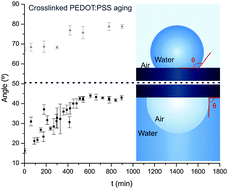Wettability of PEDOT:PSS films†
Abstract
Conducting polymers such as poly(3,4-ethylenedioxythiophene) polystyrene sulfonate (PEDOT:PSS) are increasingly used to interface electronics with biology. Their wettability, however, remains poorly understood. We show that the frequently-used sessile drop technique yields results that are strongly dependent on the experimental conditions (measurement duration and relative humidity), due to the hydrogel-like behavior of PEDOT:PSS. In contrast, the captive bubble technique on a fully wet film overcomes these limitations. Dynamic wettability measurements provide hysteresis values for this polymer and clarify the physical meaning of the static contact angles measured by sessile drop and captive bubble. Finally we show that aging the films in water leads to loss of PSS chains which makes the films more hydrophobic. The addition of a crosslinker reduces and slows down these effects.



 Please wait while we load your content...
Please wait while we load your content...